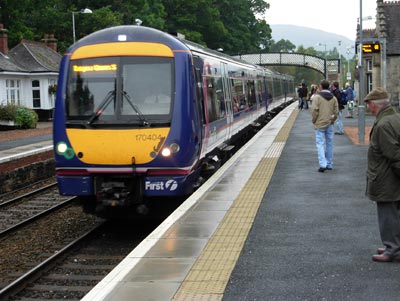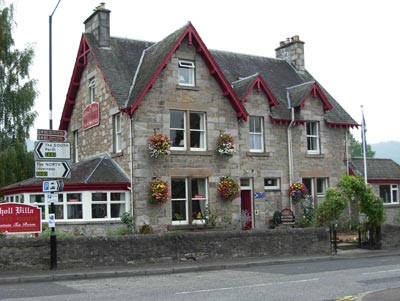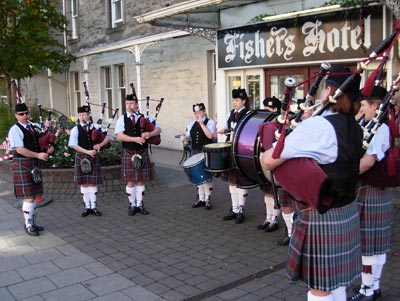Searching for family ties in Scotland
by Richard Reid, Clarkston, WA
Since the mid-18th century, Scottish immigrants have contributed to the growth of the United States, Canada, New Zealand, Australia and elsewhere. For those wishing to discover their Scottish heritage, there is no better way than to go to the country from which those immigrants originated.
What usually is discovered, however, is that these ancestors came from small, isolated villages or towns. With that being the situation, the best approach is to develop your own itinerary and work with an in-country tour operator.
My own journey of discovery took place during the first 10 days of October ’07. Although I had been to Scotland three times previously, all of the sights were seen from a tour bus. This time I needed the flexibility of staying in small towns and making impromptu stops at rural churchyards and cemeteries.
I decided to build my trip around attending the annual gathering of Clan Duncan (Donnachaidh in Gaelic) at Pitlochry in Perthshire. My family qualifies for membership in the clan, and I hoped that through interaction with Duncan clan members in Scotland I might learn more about it.
Making plans
After reviewing some possible tour operators on the Internet, I settled on sending my e-mail inquiry to Scottish Highland Trails (7 Dalmahoy Crescent, Balereno EH14 7DF, Scotland; phone +44 [0] 131 449 9500, www.highlandtrails.com). To my surprise, I received an immediate response from Alex Hood, the company’s Operations Director, who called me from Viet Nam at 2 a.m. Pacific time.
I sent him an e-mail with my trip objectives and proposed itinerary, which included visits to Campbeltown and Logierait, where two of my great-grandfathers lived before emigrating to America in the mid- 1800s. To wrap up the trip, I wanted to spend a couple of days sightseeing in Edinburgh.
Not having driven in the UK before, I looked at options not involving a car rental. Getting to and from Campbeltown was going to be the difficult part. It is served by air and intercity bus, but these would limit flexibility.
For that part of the trip, I opted for Alex to drive me from Glasgow’s airport to Campbeltown and on to Pitlochry, where he would leave me for five days to participate in the clan gathering. Following the gathering, I would take the train to Edinburgh and Alex would pick me up there for the return to Glasgow at the end of the visit.
Anyone making a trip to seek out ancestors should do as much homework as possible before leaving. I had discovered through correspondence that some of my relatives were buried in a cemetery at Southend, literally at the very south end of the Kintyre Peninsula, five miles south of Campbeltown and only 12 miles from Ireland.
I also discovered through Internet research that one of my great-grandfathers likely came from the village of Logierait on the River Tay, about five miles south of Pitlochry in Perthshire.
With this knowledge and the flexibility of independent travel, I was able to incorporate stops at both locations into the itinerary in advance.
The flights to and from Scotland were arranged through a travel agency in the States. No direct flights to Glasgow are available from the West Coast, and I stipulated that London be avoided, so we decided to use Continental Airlines’ nonstop from Seattle to Newark, connecting to a direct flight to Glasgow. The total cost for my round-trip flights was $966.
On Scottish soil
Scottish weather in October can be problematic, but on my arrival it was sunny and warm — including an equally warm welcome from Alex Hood. We went west from Glasgow to the ferry at Gourock, crossing to Dunoon on the Cowal Peninsula.
The drive across Cowal to the next ferry at Portavadie was a wonderful introduction to the west of Scotland. The area is hilly, bordering on mountainous, with agriculture and forestry the dominant activities.
The roads are paved, but most are 1½ lanes wide with turnouts about every 100 yards. They are not for first-time UK drivers, especially those from “right-hand” countries. I was glad Alex was driving, as I would have missed a lot of scenery by having to concentrate on the road.
The ferry landing from Cowal is at Tarbert, on Loch Fyne, which borders Kintyre on the east. From Tarbert there are two ways south to Campbeltown. The A83 hugs the west coast and is the fastest. The scenic route is the B842, which follows the east coast and offers beautiful views of Arran across the loch. This, too, is a narrow but paved track with turnouts. It takes an extra 30 minutes over the western route.
Upon arriving in Campbeltown, I stopped at the local heritage center but found nothing about great-grandfather Langwil, even though I had documentation showing that he lived there. We then drove to Southend, where Alex enthusiastically helped me search the old church cemetery for ancestors.
We returned to Campbeltown, where I spent the night at the Craigard House Hotel (Low Askomil, Campbeltown PA28 6EP, Scotland; phone 05186 554242, www.craigard-house.co.uk). The hotel, an elegant manor house converted to a full-service hotel, had views of Campbeltown harbor and an excellent restaurant.
The next morning we headed back up the Kintyre Peninsula on the A83. We stopped for a tour of Inveraray Castle (www.inveraray-castle.com), ancestral home of the Duke of Argyll and Clan Campbell. It definitely was worth the time. One can learn much about the clan and its storied place in history.
Following family history
From Inveraray, we turned north on the A819, then took the A15 and continued east through Aberfeldy, joining the A9 near Logierait, my next important stop. There we tarried at the parish cemetery, where I located and photographed many Reid gravestones.
Seeing the area today, one might ask why anyone would want to leave the beautiful and peaceful upper Tay Valley, but the land is not the best for farming, and times were tough in the mid-1800s, as it had been fewer than 100 years since the infamous Highland Clearances following the 1745 Jacobite Rising. Many of the younger sons of middle-class families, such as my great-grandfather, left for better prospects in America and elsewhere.
My stay for five days in Pitlochry was at the Atholl Villa Guest House (29 Atholl Road, Pitlochry, Perthshire PH16 5BX, Scotland; phone +44 [0] 1796 47 3820, www.athollvilla.co.uk), operated by Robin and Joyce McConnell. It is a comfortable large stone house at the south end of the Pitlochry business district, which can be walked end to end in about 15 minutes.
Pitlochry, once part of one of the Pictish kingdoms, is now a resort town on the main road from Perth to Inverness with several hotels, guest houses, restaurants and pubs. It also is home to Edradour distillery (phone 01796 472 095, www.edradour.co.uk), Scotland’s smallest.
The Clan Duncan gathering was filled with events which brought together the Duncan, Reid and Robertson families that make up the clan. For those seeking Scottish genealogical information combined with a good time, a clan gathering is an excellent opportunity to make helpful contacts or do on-location research. A good source of information on clan societies is The Highlander magazine (800/607-4410, www.highlandermagazine.com).
On to Edinburgh
Train service from Pitlochry to Edinburgh and Glasgow is frequent, so I was surprised to find the midday train to Edinburgh completely full on a Monday with folks coming down from Inverness.
We arrived on time at Waverley Station, where I was met by Alex, who took me the short distance to the Radisson SAS Hotel (80 High St., Edinburgh EH1 1TH, Scotland; phone 0131 557 9797, www. edinburgh.radissonsas.com) for my 2-night stay. The Radisson is a nice, American-style hotel with large rooms and expected amenities.
My day in Edinburgh was the only day on the trip that it rained. Since I had been to the city previously, I decided to spend the day at the combined Royal Museum and Museum of Scotland (Chambers St.; phone 0131 225 7534, www.nms.ac.uk), both open daily, with free entry. It is a wonderful museum combination and visitors can easily spend a full day there.
On Wednesday morning, Alex was there as scheduled to take me back to Glasgow for my trip home. I asked if we could stop at the Bannockburn battle site, which is to Scots what Yorktown is to Americans. He was obliging, and we spent about a half hour there.
The Bannockburn Heritage Centre (Glasgow Road, Stirling; phone 01786 812 664), open daily and with admission £5, is well done and gives a feeling for the time and place of the battle, but the field itself has only a large statue of Robert the Bruce and a monument with no interpretive signs.
We continued on the motorway to Glasgow, where I stayed the night at the Millennium Hotel on George Square (40 George Square, Glasgow G2 1DS, Scotland; phone 0141 322 6711, www. millenniumhotels.com) before my trip to the airport the next morning by taxi ($40).
A few observations
One thing to be aware of when traveling in Scotland is that meals, especially in hotel restaurants, are expensive. At first, menu prices look reasonable, but remember that they are in British pounds and, at current exchange rates, need to be doubled to give a dollar equivalent.
Also, big-city hotels no longer are including breakfast; at the Radisson the breakfast buffet cost $30.
The best value for lunch and dinner is at any of the numerous pubs. You probably can save 25% to 30% on meal costs by eating in pubs.
Scottish Highland Trails did an excellent job of organizing my trip and provided helpful suggestions during planning. Alex Hood proved to be a good host, engaging in delightful conversation during our drive around Scotland.
The total cost for the trip was £1,405 ($2,810), which included a car and driver for 2½ days, hotels, ferry fares, train tickets, the VAT of 17.5% and breakfasts at all locations except Edinburgh and Glasgow. Lunches and dinners were not included, nor was airfare.
Using a driver is recommended if you will be on roads that will demand your attention and prevent sightseeing. Unless you are going to rather remote spots, such as Campbeltown, most places in Scotland can be reached by train or intercity bus; you’ll just sacrifice some flexibility.
To get the most from your trip to find where your ancestors came from in any country, do the homework up front. Learn as much as you can from the Internet or other sources before leaving or contacting a tour operator. You’ll increase the chances that your quest will be fruitful and enjoyable.




